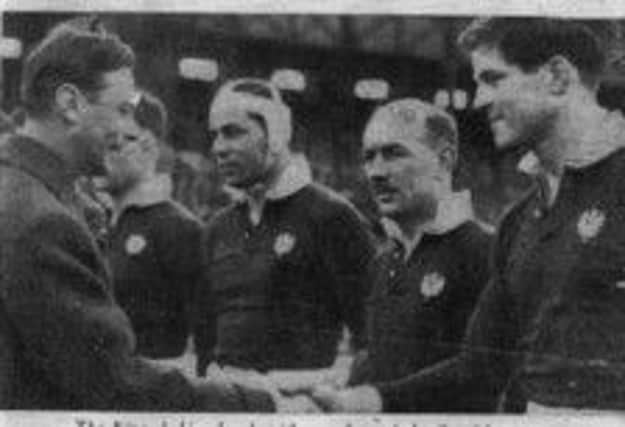Obituary: William Brewitt Young, Scotland’s oldest rugby internationalist


SCOTTISH sport has lost its final link with the famous 1938 Triple Crown winning team with the death of Bill Young – but the Ayrshireman made sure that great historical connection had a long life.
It is perhaps typical of the spirit within the big Scotsman that though a quiet, unassuming doctor, who never smoked or drank, the richness of his life also revealed a desire to hold on to the title of Scotland’s oldest living internationalist almost until his 97th birthday.
Advertisement
Hide AdAdvertisement
Hide AdYoung was born in Ardrossan, but his family left for the south soon after and he attended the City of London School. He studied medicine at Cambridge University (St Catherine’s) and his performances as a big flanker/No8 there and for King’s College Hospital and London Scottish caught the eye of Scotland selectors.
He once said that his big hands, often likened to shovels, were better suited to rugby than the precision of surgical medicine, but he excelled in both.
His rugby career reached international level in 1937 when, in response to a whitewash in the 1936 Home Nations, Scotland called up Young as one of seven newcomers for the opening game of 1937, the championship’s 50th anniversary.
It was against Wales in St Helens and Scotland won 13-6 and though they lost the next two games, against Ireland and England – France were suspended at this time for making payments to players – Young’s strength and skilful ball-playing marked him out as a key figure and he was to remain in the side throughout 1937 and 1938.
He was one of the few as the selectors again rung the changes with eight new caps being called up for the first match of 1938, including new back row Wilfrid Crawford, who would go on to score a try and kick the conversion and a penalty in an 8-6 win against the Welsh at Murrayfield.
This championship was to become renowned for its flair, with Scotland’s attacking skills at its apex. The Scots defeated Ireland 23-14 with four tries scored, also at Murrayfield, before heading south to meet England at Twickenham, where more than 70,000 people filled the ground for the first live televised rugby match and both teams were introduced to King George VI, father of the current monarch.
The Scots won 21-16 with stand-off Wilson Shaw scoring two tries and having a hand in the others scored by William Renwick and Charles Dick, with No8 Crawford adding two penalty kicks. Young played in all three games of the following season, all lost, but he was one of only five players who would re-appear after the Second World War, though not immediately.
With Ian Henderson the only pre-war survivor, 14 new caps played in Scotland’s first post-war game in 1947, against France, but all four championship games were lost, and in 1948 experienced former caps were recalled. Centre John “Donny” Innes returned to captain the side and Copland “Copey” Murdoch was restored to full-back before, in the final championship game against England at Murrayfield, Young was recalled to the back row and scored a crucial try in a 6-3 victory. That was to prove his final Test match, at the age of 31.
Advertisement
Hide AdAdvertisement
Hide AdMurdoch only won nine Scotland caps, but his 14-year career remains a record. Young finished on ten caps over 12 years, but, reading accounts of their influence on the teams of the time, they probably would have secured more than 30 and been among the record cap-holders of their generation had war not intervened and taken away six years of international rugby.
Married to Betty, Bill left the UK to work as medical missionary in Kapsowar, Kenya, where he performed countless operations to help local people. But he retained his passion for rugby and represented East Africa three times, earning caps for each game, in 1949 and 1950. Only one other rugby internationalist from a leading nation, Ireland’s Maurice Daly, has also been capped by East Africa.
They returned to the UK a few years later, however, due to Betty’s ill-health, and he worked as a GP in Kent until retiring in the 1970s, and not long after Betty passed away. They had three children, Sue, Simon and Andy.
Bill developed a strong friendship with Flora, another Ayrshire native, who had also spent time in Africa with her late husband Kedrick, and that friendship led to a marriage of two kindred spirits in Sevenoaks in May 1993.
With Flora’s children Paul, Ruth and Sheila now part of the family, Bill was proud of his own rugby XV and replacements in the shape of grandchildren and great-grandchildren. His family remember him as a man with a strong moral compass, a tee-totaller who lived the values that he espoused, and friends will long remember his great sense of humour.
A friend of Young’s, David Thomson, told us: “He lived a very full life and he and Flora were great together, and great friends. I will remember him for his warmth of spirit and great sense of humour. He really was the loveliest man.”
The funeral will take place in Sevenoaks tomorrow with a service of thanksgiving in the Vine Street Hall in Sevenoaks where Bill and Flora were married almost exactly 20 years ago.